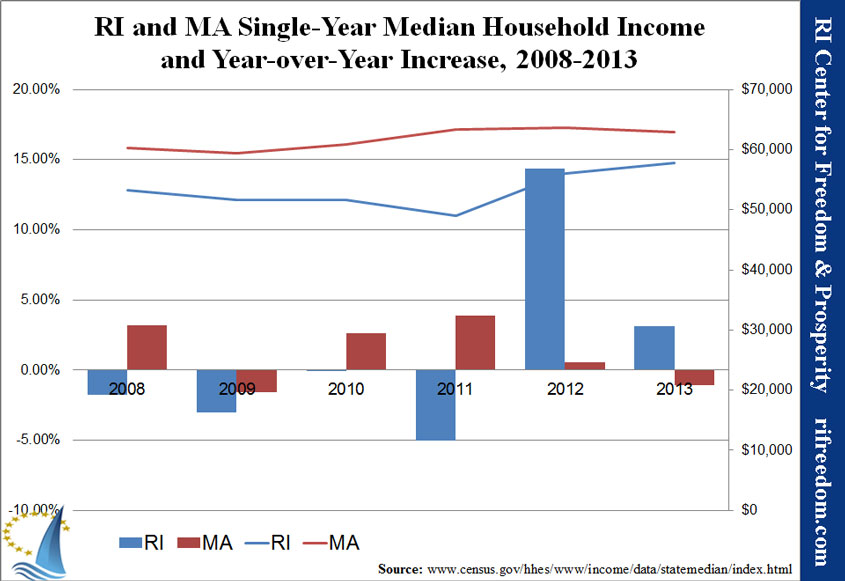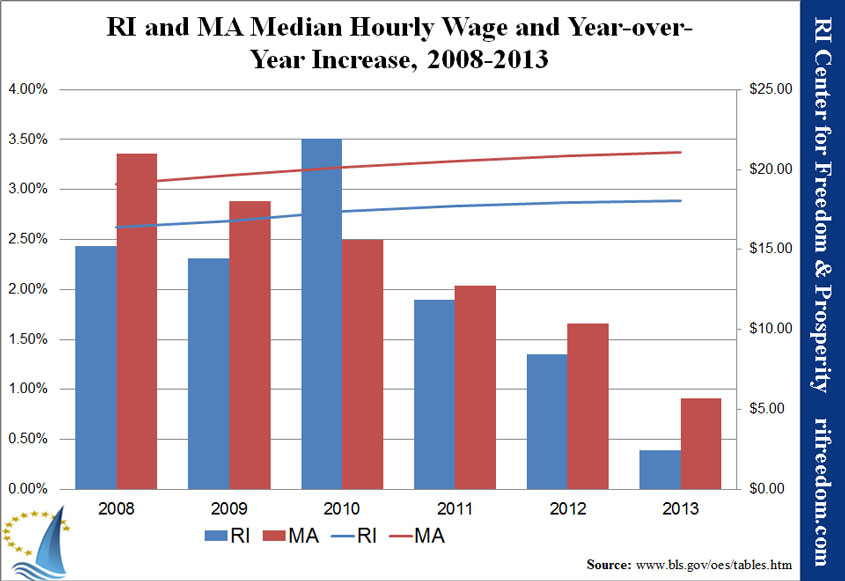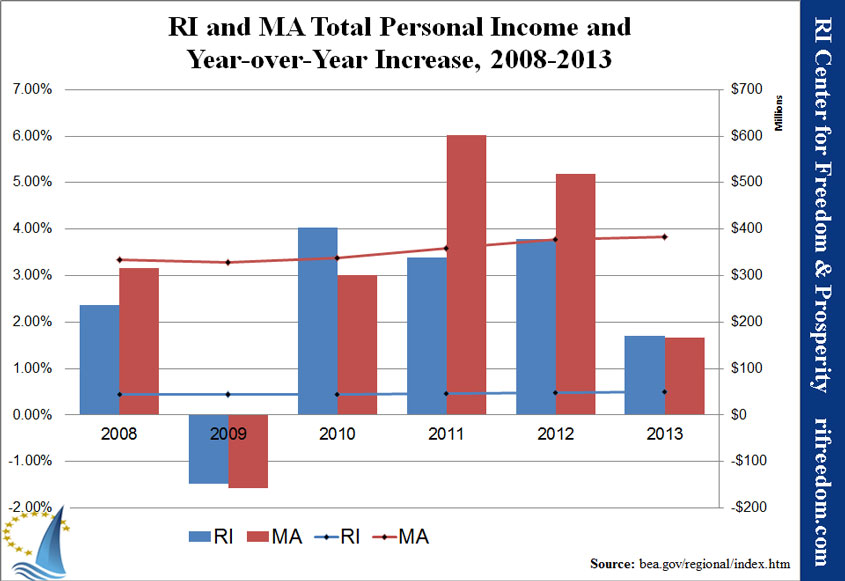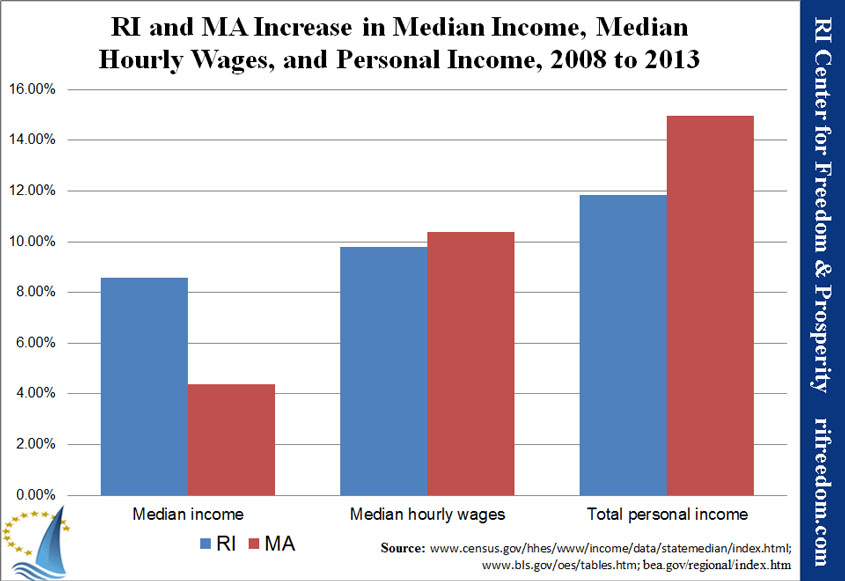What Job Creation Versus Job Destruction Says About Rhode Island’s Economy, Part 3 of 4
Income, Wages, Medians, and Totals Bring Light, Too
So far, in this mini-series of posts, I’ve argued that Rhode Island’s high job creation rate (compared with Massachusetts) is more indicative of its unhealthy job destruction rate than of a healthy business climate and that evidence suggests that RI’s job gains are in large part just bursts of effort from new establishments that tend to struggle after they open their doors. Separately, I’ve argued that Rhode Island’s employment trend is one of established companies gradually absorbing the entrepreneurial economy, which both drives out self-starters and the hyper-motivated and hinders our ability to find a new direction for our state’s economy that would benefit everybody.
That’s all kind of abstract, though, and the import is arguable. Especially in a state and a region that seems irrationally comfortable with the idea of allowing centralized government to take care of us all (from cradle to grave, as the catchphrase goes), that alone isn’t a concern. If a free-market system would be driving out non-entrepreneurs, and if expanding established organizations can continue to improve the lot of those who remain, maybe these trends indicate a rational, altruistic decision. And even fans of the free market would have to allow that watching businesses go out of business can sometimes be healthy, if those that remain are stronger and improve the overall well-being of the society.
Is that what’s happening?
Looking at median household income trends for Rhode Island and Massachusetts would seem to suggest that the answer is “yes.”
The columns show the year-over-year percentage increase or decrease in median household income while the lines show the actual dollar amount of the median. From this chart, it looks like things were rough in Rhode Island through 2011, but that something happened after that leading to a big jump. Even though that boost moderated in 2013, Rhode Island still managed to make gains while Massachusetts slipped back a hair. During the six years shown, Rhode Island wound up closing the gap with its northern neighbor some.
But this is household income. It could be that the change isn’t so much economic as cultural. Maybe household types are different, or maybe Rhode Islanders are choosing to work more. Either of those could be healthy trends, and if true, either of them would bolster my argument that anything good about Rhode Island’s employment results is happening in spite of the business climate.
When times are hard, it could be that families think twice before breaking themselves up into separate (and lower-income) households. (That can be both healthy, as with less divorce, and unhealthy, as with prolonged adolescence for young adults.) When the state is driving people out, more work remains for those still here, and the insecure workers who are still around may be motivated to pick up some extra income.
This line of inquiry deserves more in-depth investigation, but for my purposes, here, I’ll just break the median household income down to median hourly wages. The results aren’t decisive, not the least because of the way the Bureau of Labor Statistics estimates this data; where annual or hourly data is not available, the bureau estimates one from the other based on a “standard” work year. That isn’t helpful if it’s important to know how much people are working; somebody who earns more for working more, but for whom there isn’t a reported hourly wage would still look like he or she got a raise, rather than busted his or her rump.
Nonetheless, as a quick comparison to household income, the data’s worth considering.
There are two major differences from household income that are obvious, here. First, median wages never decreased. That would tend to indicate that, in years when household income dropped, there was just less work being done. Second, although both data sets show Massachusetts’s having an advantage in most years, when we look at median wage, Rhode Island’s overall result was not to close the gap, but to lose a little ground.
Basically, in the mix of all jobs in the state, Massachusetts outpaced Rhode Island when it came to ensuring that more people had higher wages. That’s especially significant considering that Rhode Island’s median wage started out lower and that Massachusetts has created more jobs.
The idea of a job “mix” is important. There are three ways a median, whether household income or wages, can go up:
- Everybody is getting more.
- There is an increase in people above the median.
- There is a decrease in people below the median.
Well, we know from the number of jobs created in each state that the answer must include a relative decrease in people in the workplace in RI versus MA. The following chart puts that in terms of income — specifically, the total personal income of everybody within the state.
Mostly, this confirms that, compared with Massachusetts, Rhode Island’s problem is that the totals aren’t growing enough. To sum it all up, here’s a chart of the overall growth rates for each of the above metrics from 2008 to 2013.
So, since the recession, compared with Massachusetts:
- RI has fewer people employed.
- RI’s story has more to do with job destruction than job creation.
- RI’s established businesses are absorbing the entrepreneurial economy.
- RI’s median household income has nonetheless gone up.
- RI’s median hourly wage has gone down.
- RI’s total personal income has gone down even more.
Even with all of the charts and tables, extracting conclusions from all of the data is still a matter of interpretation, but my initial theory continues to coincide with the various data. Since the beginning of 2010, Rhode Island’s labor force has been on a consistent decline. People are giving up.
Those who continue to work are increasingly working for other people. And although their total personal income is up a little bit, it’s not keeping pace with Massachusetts. To some extent the gap is a function of hourly wages’ not keeping pace, but more importantly, it’s a function of people below the median pulling out.
The insider culture may be helping some established people maintain their standard of living (somewhat), but the system is driving out exactly the people with the most incentive to innovate and work. That may be a downward spiral, as the establishment further entrenches and fears change. A state that isn’t growing enough may start to shrink, especially if people aren’t doing the sort of experimenting that could define a new direction.
In the last part of the series, I’ll at self-employed people who don’t have any employees themselves.







